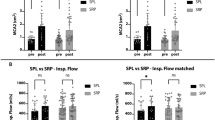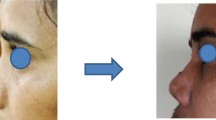Abstract
Purpose
Functional and aesthetic results after septorhinoplasty (SRP) are often not clearly demonstrated. There is still an open topic in the literature about analysis of aesthetic, functional results and patients’ satisfaction after SRP. The aim of our study is to determine patients’ satisfaction after SRP and concomitant radiofrequency of the inferior turbinate (RF) regarding nose appearance and improvement of symptoms, using patient reported outcome measures (PROMs).
Methods
ROE questionnaire and the NOSE scale were used for a retrospective evaluation to assess patient’s satisfaction in 369 patients undergoing SRP surgery from 2003 to 2016. Two additional questions were asked to confirm satisfaction following surgery.
Results
258 patients completed the questionnaires (71.7%). The global average ROE score was 18.14 (75.6%). The percentage of satisfaction of aesthetic result was 87.3%, in particular 10.5% were very happy, 57% very much satisfied and 19.8% moderately satisfied. The global post-operative average NOSE score was 13.1 with the resolution of nasal obstruction in 72.1% cases and a marked improvement in 9.3%. The results of the two additional questions showed that 81% of patients would undergo the procedure again if required and 72.1% of patients were globally satisfied.
Conclusions
Our study demonstrates the utility of PROMs in evaluating aesthetic and functional results after SRP and simultaneous RF. In our series, the patients undergoing SRP and RF are generally satisfied by the functional and aesthetic results. This kind of assessments should be the most common post-operative evaluation methods in this surgery.
Similar content being viewed by others
References
Meyer L, Jacobsson S (1986) The predictive validity of psychosocial factors for patient acceptance of rhinoplasty. Ann Plast Surg 17:513–520
Andre´ RF, Vuyk HD, Ahmed A, Graamans K, Nolst Trenite´ GJ (2009) Correlation between subjective and objective evaluation of the nasal airway. A systematic review of the highest level of evidence. Clin Otolaryngol 34:518–525
Jones AS, Willatt DJ, Durham LM (1989) Nasal airflow: resistance and sensation. J Laryngol Otol 103:909–911
Kim CS, Moon BK, Jung DH, Min YG (1998) Correlation between nasal obstruction symptoms and objective parameters of acoustic rhinometry and rhinomanometry. Auris Nasus Larynx 25:45–48
Andrews PJ, Choudhury N, Takhar A, Poirrier AL, Jacques T, Randhawa PS (2015) The need for an objective measure in septorhinoplasty surgery: are we any closer to finding an answer? Clin Otolaryngol 40:698–703
Alsarraf R (2000) Outcomes research in facial plastic surgery: a review and new directions. Aesthet Plast Surg 24:192–197
Alsarraf R, Larrabee WF, Anderson S, Murakami CS, Johnson CM (2001) Measuring cosmetic facial plastic surgery outcomes: a pilot study. Arch Facial Plast Surg 3:198–201
Stewart MG, Witsell DL, Smith TL, Weaver EM, Yueh B, Hannley MT (2004) Development and validation of the Nasal Obstruction Symptom Evaluation (NOSE) Scale. Otolaryngol Head Neck Surg 130(2):157–163
Barone M, Cogliandro A, Di Stefano N, Tambone V, Persichetti P (2017) A systematic review of patient-reported outcome measures after rhinoplasty. Eur Arch Otorhinolaryngol 274(4):1807–1811
Izu SC, Kosugi EM, Brandao KV, Lopes AS, Garcia LB, Suguri VM, Gregorio LC (2012) Normal values for the Rhinoplasty Outcome Evaluation (ROE) questionnaire. Braz J Otorhinolaryngol 78:76–79
Biggs TC, Fraser LR, Ward MJ, Sunkaraneni VS, Harries PG, Salib RJ (2015) Patient reported outcome measures in septorhinoplasty surgery. Ann R Coll Surg Engl 97(1):63–65
Katz S, Schmelzer B, Vidts G (2000) Treatment of the obstructive nose by CO2-laser reduction of the inferior turbinates: technique and results. Am J Rhinol 14:51–55
Pirila T, Tikanto J (2001) Unilateral and bilateral effects of nasal septum surgery demonstrated with acoustic rhinometry, rhinomanometry, and subjective assessment. Am J Rhinol 15:127–133
Passali D, Lauriello M, Anselmi M, Bellussi L (1999) Treatment of hypertrophy of the inferior turbinate: long-term results in 382 patients randomly assigned to therapy. Ann Otol Rhinol Laryngol 108:569–575
Jessen M, Malm L (1984) The importance of nasal airway resistance and nasal symptoms in the selection of patients for septoplasty. Rhinology 22:157–164
Carney AS, Bateman ND, Jones NS (2000) Reliable and reproducible anterior active rhinomanometry for the assessment of unilateral nasal resistance. Clin Otolaryngol 25:499–503
Radulesco T, Penicaud M, Santini L, Thomassin JM, Dessi P, Michel J (2017) Outcomes of septorhinoplasty: a new approach comparing functional and aesthetic results. Int J Oral Maxillofac Surg 47(2):175–179
Sipila J, Suonpaa J, Silvoniemi P, Laippala P (1995) Correlation between subjective sensation of nasal patency and rhinomanometry in both unilateral and total nasal assessment. ORL J Otorhinolaryngol Relat Spec 57(5):260–263
Hirschberg A (2002) Rhinomanometry: an update. ORL J Otorhinolaryngol Relat Spec 64:263–267
Bermuller C, Kirsche H, Rettinger G, Riechelmann H (2008) Diagnostic accuracy of peak nasal inspiratory flow and rhinomanometry in functional rhinosurgery. Laryngoscope 118(4):605–610
Starling-Schwanz R, Peake HL, Salome CM et al (2005) Repeatability of peak nasal inspiratory flow measurements and utility for assessing the severity of rhinitis. Allergy 60:795–800
Clement PAR, Gordts F (2005) Consensus report on acoustic rhinometry and rhinomanometry. Rhinology 43:169–179
Hassan SJ, Weymuller EA (1993) Assessment of quality of life in head and neck cancer patients. Head Neck 15:485–496
Deleyiannis FW, Weymuller EA, Coltrera MD, Futran N (1999) Quality of life after laryngectomy: are functional disabilities important? Head Neck 21:319–324
Rosenfeld RM (1995) Pilot study of outcomes in pediatric rhinosinusitis. Arch Otolaryngol Head Neck Surg 121:729–736+
Wähmann MS, Bulut OC, Bran GM, Veit JA, Riedel F (2018) Systematic review of quality-of-life measurement after aesthetic rhinoplasty. Aesthet Plast Surg https://doi.org/10.1007/s00266-018-1199-6
Sinno S, Mehta K, Lee ZH, Kidwai S, Saadeh PB, Lee MR (2016) Inferior turbinate hypertrophy in rhinoplasty: systematic review of surgical techniques. Plast Reconstr Surg 138(3):419e–419e29e
Parrilla C, Artuso A, Gallus R, Galli J, Paludetti G (2013) The role of septal surgery in cosmetic rhinoplasty. Acta Otorhinolaryngol Ital 33(3):146–153
Saleh AM, Younes A, Friedman O (2012) Cosmetics and function: quality-of-life changes after rhinoplasty surgery. Laryngoscope 122:254–259
Başer E, Kocagöz GD, Çalim ÖF, Verim A, Yilmaz F, Özturan O (2016) Assessment of patient satisfaction with evaluation methods in open technique septorhinoplasty. J Craniofac Surg 27(2):420–424
Author information
Authors and Affiliations
Corresponding author
Ethics declarations
Conflict of interest
The authors declare that they have no conflict of interest.
Ethical approval
For this type of study, formal consent is not required.
Informed consent
Informed consent was obtained from all individual participants included in the study.
Rights and permissions
About this article
Cite this article
Parrilla, C., Salvati, A., Mastrapasqua, R.F. et al. Functional and aesthetic results after septorhinoplasty and concomitant radiofrequency of the inferior turbinate: is there a role for patient reported outcome measures (PROMs)?. Eur Arch Otorhinolaryngol 276, 745–751 (2019). https://doi.org/10.1007/s00405-018-05269-5
Received:
Accepted:
Published:
Issue Date:
DOI: https://doi.org/10.1007/s00405-018-05269-5




